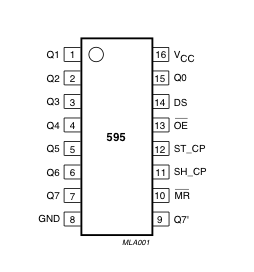
| PINS 1-7, 15 | Q0 " Q7 | Output Pins |
| PIN 8 | GND | Ground, Vss | |
| PIN 9 | Q7" | Serial Out | |
| PIN 10 | MR | Master Reclear, active low | |
| PIN 11 | SH_CP | Shift register clock pin | |
| PIN 12 | ST_CP | Storage register clock pin (latch pin) | |
| PIN 13 | OE | Output enable, active low | |
| PIN 14 | DS | Serial data input | |
| PIN 16 | Vcc | Positive supply voltage |
Shifting Out & the 595 chip
At sometime or another you may run out of pins on your Arduino board and
need to extend it with shift registers. This example is based on the
74HC595. The datasheet refers to the 74HC595 as an "8-bit serial-in,
serial or parallel-out shift register with output latches; 3-state." In
other words, you can use it to control 8 outputs at a time while only
taking up a few pins on your microcontroller. You can link multiple
registers together to extend your output even more. (Users may also wish
to search for other driver chips with "595" or "596" in their part
numbers, there are many. The STP16C596 for example will drive 16 LED's and eliminates the series resistors with built-in constant current sources.)
Read more: http://arduino.cc/en/Tutorial/ShiftOu
Shift register @ WikipediaIn digital circuits, a shift register is a cascade of flip flops, sharing the same clock, in which the output of each flip-flop is connected to the "data" input of the next flip-flop in the chain, resulting in a circuit that shifts by one position the "bit array" stored in it, shifting in the data present at its input and shifting out the last bit in the array, at each transition of the clock input. More generally, a shift register may be multidimensional, such that its "data in" and stage outputs are themselves bit arrays: this is implemented simply by running several shift registers of the same bit-length in parallel.
Shift registers can have both parallel and serial inputs and outputs. These are often configured as serial-in, parallel-out (SIPO) or as parallel-in, serial-out (PISO). There are also types that have both serial and parallel input and types with serial and parallel output. There are also bi-directional shift registers which allow shifting in both directions: L→R or R→L. The serial input and last output of a shift register can also be connected to create a circular shift register.
Read more: http://en.wikipedia.org/wiki/Shift_register
No comments:
Post a Comment